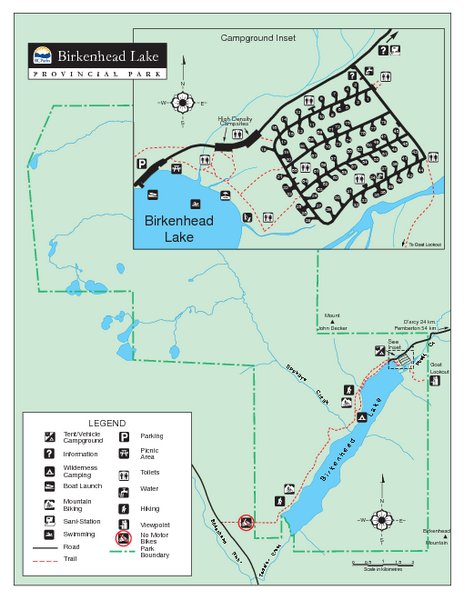Birkenhead Lake Provincial Park
IUCN Category II - National Park
The beach at Birkenhead Lake
The Birkenhead Lake Provincial Park is a 10,439 -hectare Provincial Park in the center of the Canadian province of British Columbia. The park is located in the Chilcotin Ranges of the Coast Mountains, about 50 kilometers northeast of Pemberton Squamish - Lillooet Regional District in.
Plant
The park is somewhat remote from the large and paved roads at the same Birkenhead Lake. The official access to the park and the campground is via a 21 km long unpaved gravel road.
The park is divided into two parts. The largest part of the park is located northwest of Birkenhead Lake, while to the southeast of the lake then there is the smaller part of the park. The northeastern end of the lake, the campground is still in the park. The southwestern end of the lake, with a small settlement, no longer belongs to the park
The park is crossed by several small lakes, streams and rivers. The most important of the streams is the Sockeye Creek. There are several mountains in the park area. The highest mountains are:
- Sockeye Horn ( 2498 meters, in the northwest of the park)
- Tolkien Peak ( 2380 meters, in the north- east of the park )
- Mount McDonald ( 2281 meters, in the southeast of the park)
In the park is a protected area category II (National Park).
History
The park was established in 1963 and has, like the lake, named after a sunken ship, the HMS Birkenhead. At its founding, the park only had a size of 3642 hectares. Over time, the park boundaries was repeatedly redefined and the park grew it every time.
The park is located mainly in the traditional hunting and settlement area of the St'at'imc, but also of Squamish. The First Nations use the area but still fishing.
Flora and Fauna
The park is located at the transition between the relatively wet Coast Mountains and the much drier interior plateau. Within the ecosystem of British Columbia, the park area is classified into four different zones, the Coastal Western Hemlock zone ( with subzones dry submaritime and moist submaritime ), the Englemann Spruce - Subalpine fir zone ( with subzones moist warm and moist hot parkland ), the Interior Douglas - fir zone ( subzone with the wet warm) and the Alpine tundra zone.
A forestry use on a larger scale did not take place in the park. Therefore, it will also provide still very much primary forest. More than 70% of the forest area in the park have an age of more than 140 years. Due to the four, sometimes very different zones can be found in the park, a relatively large number of plants. It can be found next to widespread species such as Douglas fir, Western Hemlock, red cedar and Engelmann spruce also significantly rarer species such as Western White pine and hemlock mountain. This diversity is also reflected in the undergrowth with Shallon bill berry, Rotstängelmoos, umbels umbellata and ordinary Oregon grape.
The detectable species correspond to the location of the park. In the area you will find among other things, the grizzly bear. In addition to various deer species, there are also mountain goats in the park. Besides coming here because of the old trees, and the Pileated woodpecker and spotted owl before. The Sockeye Creek also offers proven habitat for the protected bull trout ( Salvelinus confluentus ). In the lake and the streams and rivers we also find sockeye and rainbow trout.
Activities
The park has 91 partially reservable, pitches for caravans and tents and has a simple plumbing system.
The tourist attraction of the park is the one of the Birkenhead Lake and on the other of the numerous hiking and climbing opportunities. On different paths in the park, the use of mountain bikes are allowed.
On the lake it is allowed to go by motor boat. He is also an excellent fishing spot.










